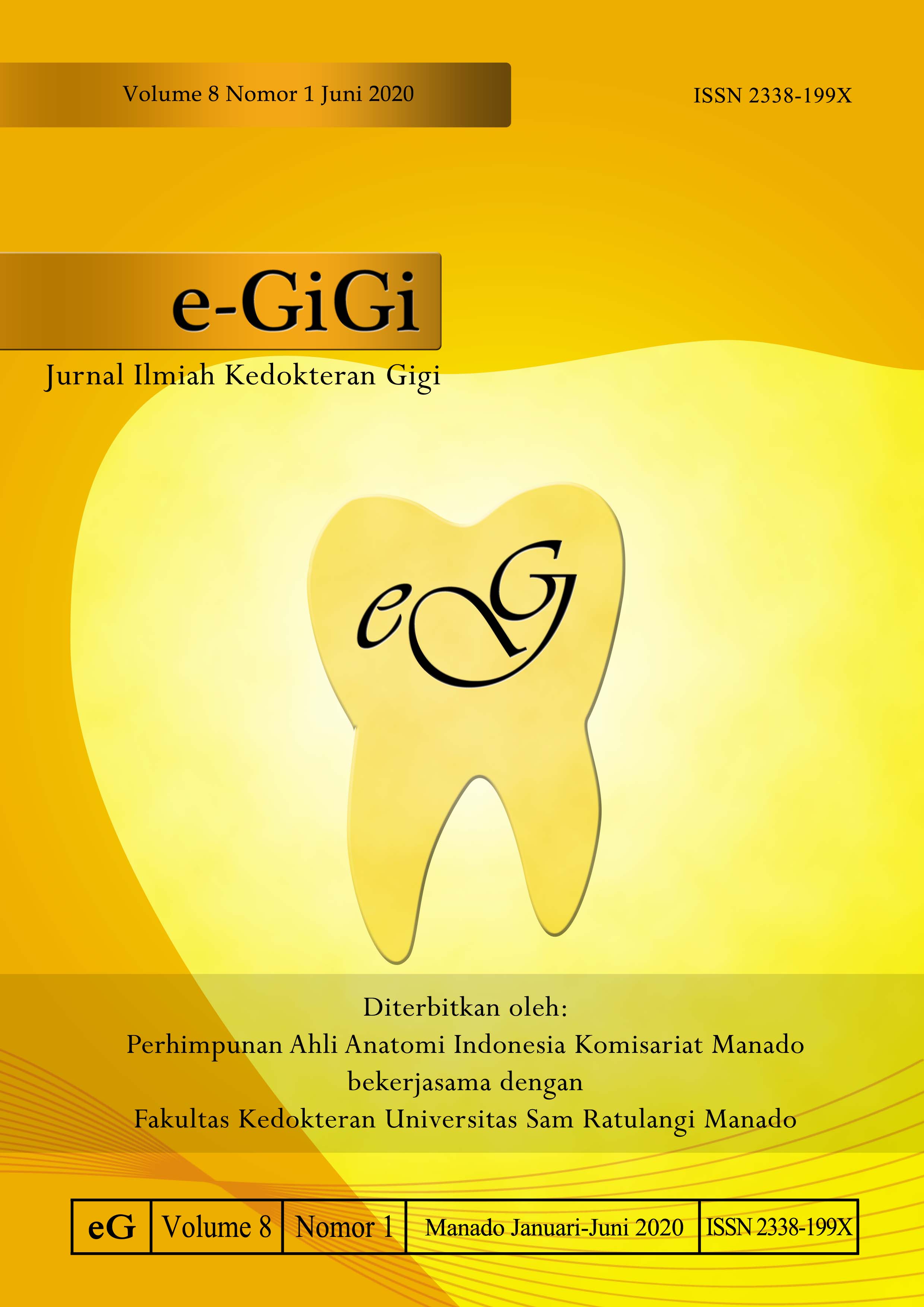Analisis Jejas Gigitan pada Kasus Forensik Klinik
DOI:
https://doi.org/10.35790/eg.8.1.2020.27094Abstract
Abstract: Examination of bite mark is one form of dental assistance for the enforcement of justice. A dentist can examine bite mark or be asked his/her expert assessment of bite mark that has been recorded by another dentist. The source of bite marks, the substrate onto which they are generated, and the technique of lifting the bite imprints serve as important tools in analysis. This study was aimed to obtain mengetahui seberapa besar analisis jejas gigitan dapat mengungkapkan pelaku. This was a retrospective and descriptive study, using clinical forensic data from RS Bhayangkara Tingkat III in Manado from January 2015 to December 2019. This study used 2,197 clinical forensic cases data, of which there were 34 cases with bite marks. The most common bite sites were found in the arms (23.4%) and the least locations were found on the cheeks and neck (0.2%). There were 85.29% of bite marks that could be matched with suspected tooth molds. In conclusion, as many as 85.29% of bite marks in this study could be matched with suspected tooth molds. Albeit, mismatch of tooth patterns is not automatically removed somebody from the suspect list. Determinant variables such as the location of bite mark, movement of the jaw or part of the body bitten, and the process of inflammation in the body of the victim must be used as material for analysis in identifying the perpetrators.
Keywords: bite mark, forensic odontology, identification of suspect
Â
Abstrak: Pemeriksaan jejas gigi (bite mark) merupakan salah satu bentuk bantuan dokter gigi bagi penegakan keadilan. Seorang dokter gigi dapat diminta melakukan pemeriksaan dan analisis jejas gigi atau diminta untuk memberikan keterangan ahli tentang jejas gigi yang telah diperoleh dokter gigi lain. Sumber bekas gigitan, media yang digunakan untuk mendokumen-tasikan dan teknik mentransfer bekas gigitan berfungsi sebagai alat penting dalam analisis. Penelitian ini bertujuan untuk mengetahui seberapa besar analisis jejas gigitan dapat mengungkapkan pelaku. Jenis penelitian ini ialah deskriptif retrospektif, menggunakan data forensik klinik dari RS Bhayangkara tingkat III Manado pada rentang tahun 2015-2019. Pada penelitian ini digunakan data dari 2197 kasus forensik klinik; diantaranya terdapat 34 kasus dengan jejas gigitan (bite mark). Lokasi jejas gigitan terbanyak ditemukan pada lengan (23,4%) dan paling sedikit pada pipi dan leher, (0,2%) serta didapatkan 85,29% jejas gigitan pada penelitian ini dapat dicocokkan dengan cetakan gigi tersangka. Simpulan penelitian ini ialah sebesar 85,2% jejas gigitan dapat mengungkapkan pelaku, namun ketidakcocokan pola gigi tidak secara otomatis menyingkirkan seseorang dari daftar tersangka. Variabel penentu seperti lokasi gigitan, pergerakan rahang atau bagian tubuh yang digigit, dan proses peradangan pada tubuh korban harus dijadikan bahan analisis dalam mengidentifikasi pelaku, agar tidak terjadi kesalahan identifikasi pelaku.
Kata kunci: jejas gigitan, odontologi forensik, identifikasi pelaku
Downloads
How to Cite
Issue
Section
License
COPYRIGHT
Authors who publish with this journal agree to the following terms:
Authors hold their copyright and grant this journal the privilege of first publication, with the work simultaneously licensed under a Creative Commons Attribution License that permits others to impart the work with an acknowledgment of the work's origin and initial publication by this journal.
Authors can enter into separate or additional contractual arrangements for the non-exclusive distribution of the journal's published version of the work (for example, post it to an institutional repository or publish it in a book), with an acknowledgment of its underlying publication in this journal.
Authors are permitted and encouraged to post their work online (for example, in institutional repositories or on their website) as it can lead to productive exchanges, as well as earlier and greater citation of the published work (See The Effect of Open Access).






